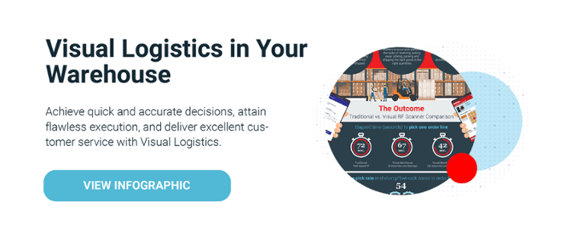4 Ways Optimizing Warehouse Picking Can Help Save Time & Money

At its essence, efficient warehouse picking is about fulfilling customer orders via your warehouse management system (WMS) with the least amount of material handling and labor output. It’s an important task to optimize as more than 50 percent of a DC’s labor force is typically involved in picking.
Many organizations today overlook easy ways to make warehouse picking more efficient and less costly. Below you’ll find four ways to tackle this problem followed by an in-depth look at various picking methods and associated technologies.
Learn more about this related supply chain topic: The Future of Warehouse Management Systems (WMS) Must Support Complex Warehouse Requirements for a New Era of Buyers
1. Analyze Your Customer and Order Profile to Determine the Best Material Handling Layout
Fine-tuning your material handling layout requires you to think about your customer base and typical order profile. A retail customer with limited shelf space may order loose pieces or full cases, while a wholesaler or other distributor may order full pallets or full cases. How you structure your warehouse layout and picking process will reflect how products are picked, and each scenario requires a different approach.
To accommodate these different order profiles, you may have a pallet rack section for full-pallet or full-case picking that leverages forklift trucks or pallet jacks and another broken case area for less-than full-case picking where product is picked from shelves, gravity flow racks, mezzanines, or conveyors.
2. Dig into Inventory Slotting
Given the size of many DCs, warehouse picking can involve a lot of time spent walking around to fulfill orders from far-flung inventory locations. Having a diverse inventory mix is often the root of inefficiency because it can take a lot of time to slot items properly. Some operations teams skip this step because they don’t know how to approach it. Yet, efficient slotting of the top 20 percent of your fast-moving items will pay significant efficiency dividends.
Luckily, your warehouse management system contains the business intelligence you need to manage your product profile in the best way based on item velocity. Simply put, you don’t want prime inventory locations devoted to slow-moving items.
Put low-hit products at the back of the warehouse or in a separate area that isn’t visited frequently. Get a handle on how fast products are moving and set up your shelves and replenishment areas accordingly. Re-slot products on a regular basis based on this data, but don’t do it too frequently (i.e., daily), because you’ll negate the benefits of good slotting with too much time spent constantly relocating inventory.
Having the pick location sized appropriately has a major impact on picking. If the location requires a high level of replenishments, order pickers will always have to wait for the product to be replenished, thus causing delays. The same works in the reverse: If the locations are too big, this causes the pick distances to increase, thus increasing travel time to complete the order picking process.
3. Evaluate Your Material Handling Equipment and Layout
Do you have the right equipment to store and pick your items? Are you using pallet rack positions to pick less-than-case-pick items? Are you taking advantage of your building height? Can you use a mezzanine or shelving system to consolidate your slow-moving or less-than-case-pick items to reduce the footprint in the warehouse?
There are many ways to get space back in your warehouse for much-needed storage while reducing the amount of travelling needed for picking orders. The type of material handling equipment (MHE) you have has a direct impact on warehouse picking efficiencies. Keeping product at ground level eliminates the need for lift equipment to retrieve goods for picking and having the user wait for the product to come to them.
4. Evaluate Automation vs. Labor Costs
It’s critical to find the right balance for your warehouse when it comes to deciding whether to purchase material handling equipment designed for picking. Oftentimes, it’s less expensive to increase the number of hourly workers instead, although considerations like speed and accuracy will factor in.
Methods of Warehouse Picking
Paper-based picking: Although increasingly less common, paper-based picking is still found in smaller warehouses with lower order volumes (typically 100 – 200 orders/day across five people). While cost-effective in the sense that costly scanners aren’t required, this type of warehouse picking risks inefficiency because the data in the warehouse management system isn’t available in real time; it doesn’t accurately reflect what’s happening in your warehouse.
Mobile Devices: Most DCs use mobile devices such as RF scanners and Android™ cell phones protected by a durable case. These technologies in concert with a warehouse management software provide a real-time view of inventory and tasks happening in your facility. So, if one associate arrives to find a depleted location, he or she can note that in the system, cycle counting the location or actually triggering a replenishment of the location should there be additional inventory. This prevents others from wasting time traveling to that location only to find the same thing. Essentially, pick commands adjust in real time.
Picking Technologies to Pair with Mobile Devices
- Order picking: In this scenario, a handheld device leads the associate through each task, asking for confirmation as each item is picked in the quantity indicated.
- Voice Picking: This is a conversation between the application and the user. The system tells the user to go to a certain location and pick a certain quantity. Once done, the user verbally confirms completion and moves onto the next prompt.
- Pick to light: This option uses lights to visually indicate the picker’s next pick location and the quantity to pick. Smart carts can also enhance this process by using a light to show which of several totes or boxes the picked product should be put into.
- Carousels/goods-to-person systems: Both horizontal and vertical carousels drive efficiency by bringing the product to the associate for picking. The associate then uses a work table to line up containers and watches a light or screen with colored indicators to determine exactly where product should be placed per the customer’s order.
WMS-Driven Picking Efficiencies
The beauty of a warehouse management software is that it can offer many options to provide the most efficient warehouse picking method—which often isn’t picking one order at a time. Each of the methods below enables associates to minimize travel time by confining their work to the smallest number of areas.
- Batch picking: An example of this would be a retailer with 50 stores where each wants the same items but in different quantities. Batch picking fulfills this in two steps. First, individual quantities are consolidated into a single pick reflecting the totally number of products required, which is dropped off in a consolidation area. Second, each individual store’s order is picked from the product in the consolidation area and put into shipping containers. This helps reduce the overall travel distances for processing all of the orders.
- Group picking: This option enables an associate to select multiple orders for processing. The group picking focuses on picking a total quantity and then parsing it out into the separate shipping containers by customer.
- Cluster picking: A user can also bring a cart of boxes designated for multiple customers to a picking area and pick product directly into each container based on the requirements.
- Pick and pass: This method, usually found in a mezzanine system, allows the associate to identify the boxes for the picking in a single zone of perhaps five to 10 flow racks. The associate can then pick the boxes in his or her zone and pass them to the next zone. Pick and pass leverages group or cluster picking, typically in less-than-case scenarios.



